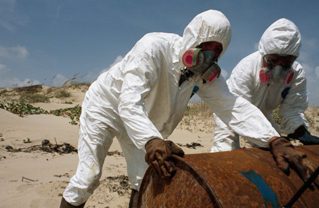
A Superfund site is an abandoned hazardous waste site that poses enough risk to human and environmental health that the Environmental Protection Agency has stepped in to lead a clean-up effort. It’s also the name of an actual fund that no longer has any money in it*
– http://www.epa.gov/superfund/about.htm

This Chandra X-ray photograph shows Cassiopeia A (Cas A, for short), the youngest supernova remnant in the Milky Way.
Credit: NASA/CXC/MIT/UMass Amherst/M.D.Stage et al.
A blindingly bright star bursts into view in a corner of the night sky — it wasn’t there just a few hours ago, but now it burns like a beacon. That bright star isn’t actually a star, at least not anymore. The brilliant point of light is the explosion of a star that has reached the end of its life, otherwise known as a supernova.
Supernovas can briefly outshine entire galaxies and radiate more energy than our sun will in its entire lifetime. They’re also the primary source of heavy elements in the universe.
https://en.wikipedia.org/wiki/Supernova
* the Superfund law originally paid for toxic waste cleanups through a tax on petroleum and chemical industries. The chemical and petroleum fees were intended to provide incentives to use less toxic substances. Over five years, $1.6 billion was collected, and the tax went to a trust fund for cleaning up abandoned or uncontrolled hazardous waste sites. The last full fiscal year (FY) in which the Department of the Treasury collected the tax was 1995. At the end of FY 1996 the invested trust fund balance was $6.0 billion. This fund was exhausted by the end of FY 2003; since that time funding for superfund sites for which the potentially responsible party (PRP) could not be found has been appropriated by Congress out of general revenues. –http://en.wikipedia.org/wiki/Superfund#Provisions

